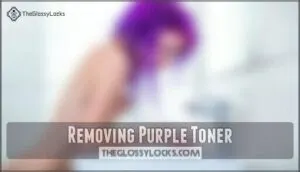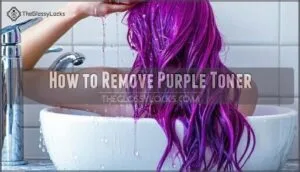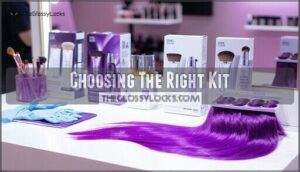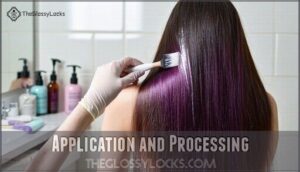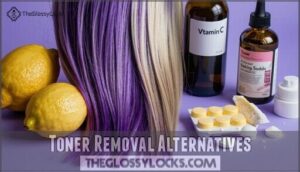This site is supported by our readers. We may earn a commission, at no cost to you, if you purchase through links.
 If you’re wondering how to remove purple toner from hair, start with a clarifying shampoo—it’s designed to strip color gently.
If you’re wondering how to remove purple toner from hair, start with a clarifying shampoo—it’s designed to strip color gently.
Lather it into wet hair, let it sit for a few minutes, then rinse thoroughly.
For stubborn toner, try a mix of dish soap and lemon juice, but don’t overdo it to avoid dryness.
Deep conditioning afterward is key to keeping your hair healthy.
You can also explore color remover kits or natural solutions like baking soda with water.
Always monitor your hair’s reaction carefully—over-processing can cause damage.
Ready to reclaim your look? There are layers to this process worth exploring.
Table Of Contents
- Key Takeaways
- Removing Purple Toner
- How to Remove Purple Toner
- Clarifying Shampoo Method
- Dish Soap and Lemon Juice
- Color Remover Kits
- Bleach Wash Technique
- Natural Toner Removal
- Preventing Over-Toning
- Toner Removal Alternatives
- Post-Removal Hair Care
- Frequently Asked Questions (FAQs)
- How do you get purple toner out of your hair?
- What cancels purple out of hair?
- How long does hair stay purple after toner?
- Can toner damage hair permanently?
- How to prevent toner over-processing?
- Will toner fade completely over time?
- Can natural oils help remove hair toner?
- Are there any toner removal methods for sensitive scalps?
- How long does purple toner typically last?
- Are there non-damaging toner removal solutions?
- Conclusion
Key Takeaways
- Use clarifying shampoo or dish soap with lemon juice to gently fade purple toner, but always follow with a deep conditioner to prevent dryness.
- You can cancel out purple tones with yellow-tinted products based on the color wheel for a balanced look.
- Natural solutions like baking soda, vinegar, or lemon juice can fade unwanted toner without harsh chemicals.
- Prevent over-toning by using purple shampoo sparingly and following product instructions closely.
Removing Purple Toner
Removing purple toner from hair can seem tricky, but it’s entirely doable with the right method.
By understanding why it happens and choosing the appropriate solution, you can restore your hair’s natural balance safely and effectively, which involves knowing how to handle the process to achieve the desired outcome with complete concepts.
Causes of Purple Toner
Purple toner buildup often stems from application errors or overusing purple shampoo.
Purple toner mishaps often arise from overusing purple shampoo or misapplying toning products, leaving hair unexpectedly over-toned.
Hair porosity plays a critical role; porous, bleached hair absorbs more pigment, leading to discoloration.
Misjudging underlying undertones during toning or incorrectly balancing toner formulation can also result in unwanted purple tones.
Product buildup further complicates purple toner removal, turning what’s meant to neutralize brassiness into an over-toned mess requiring correction.
Effects on Hair Health
The excessive use of purple toner can lead to significant hair health issues.
When you overuse toner, you may experience:
- Severe moisture loss from stripping natural oils
- Protein depletion that weakens hair structure
- Scalp irritation from harsh chemicals
- Brittle, dull hair prone to breakage
These effects aren’t just cosmetic – they can damage your hair’s integrity, requiring intensive repair treatments.
While purple toner removal is often necessary, it’s vital to balance it with damaged hair treatment protocols.
Importance of Removal
While purple-tinted hair might seem like a minor issue, removing excess toner is actually essential for both aesthetic concerns and professional appearance.
You’ll want to address it promptly to avoid buildup that can make color correction more difficult later.
Getting rid of purple toner is especially important for maintaining extensions and preserving your hair’s intended look.
When your blonde turns lavender unexpectedly, fixing purple toner becomes a priority for your confidence and style.
How to Remove Purple Toner
Panic sets in when toner correction goes wrong, but you can fix purple toner mishaps with these proven methods. Here’s how to remove purple hair effectively:
- Assess the toner fading speed – lighter stains fade faster than deeper ones
- Consider extension toner removal carefully – some methods may damage hair extensions
- Understand toner ingredient impact – ammonia-based toners require stronger removal techniques
- Weigh professional removal costs against DIY removal risks
- Choose the right method based on severity – from gentle clarifying shampoo to stronger color removers
Each solution offers a path to hair color freedom without permanent damage. For a gentler approach, consider using lemon juice chelation to fade the unwanted toner. This method can help achieve the desired result with minimal risk of permanent damage.
Clarifying Shampoo Method
To remove purple toner quickly and effectively, try using a clarifying shampoo. It’s designed to strip away buildup, but follow up with a conditioner to prevent dryness.
Application and Rinsing
Start by applying a generous amount of clarifying shampoo to damp hair, ensuring full product saturation.
Gently massage the scalp and strands to work it through. Use lukewarm water for hair rinsing, as hot water can be drying.
Many people purchase specialized shampoo products for this purpose.
Repeat the process 2-3 times for effective toner removal, focusing on thorough residue removal. Don’t rush—precision matters in hair washing.
Follow-up Conditioning
Deep conditioning after using clarifying shampoo is essential for hydration and hair repair.
Follow these steps:
- Use a protein-rich mask weekly to rebuild strength and reduce hair damage.
- Apply a leave-in conditioner or oil treatment for daily hair moisturizing and protection.
- To help rebuild and strengthen hair, consider using a specialized hair product.
- Incorporate deep conditioning treatments, focusing on hydration importance, to restore your hair’s softness and shine.
Prevention of Dryness
After rinsing thoroughly, hydration techniques are your best friend.
Clarifying shampoos can strip moisture, so restore your hair’s moisture balance with deep conditioning or oil application.
Avoiding sulfates helps prevent further hair damage.
Protein treatments strengthen strands affected by purple shampoo overuse or hair color correction.
Regular hair repair guarantees softness and resilience while protecting against dryness.
Some find that using a sulfate-free shampoo helps to avoid further hair damage.
Dish Soap and Lemon Juice
Dish soap and lemon juice offer a quick way to fade stubborn purple toner.
The dish soap acts as a clarifying agent, while the lemon juice’s acidity helps break down the color.
Mixing and Application
How can you fix purple toner effectively?
Start by mixing dish soap and lemon juice until you achieve a smooth, even toner consistency. Use application tools like a tint brush or your hands to section hair for better control.
Apply evenly, focusing on full saturation. Many people also use a clarifying hair product to remove unwanted tones.
Allow a short development time to remove purple hair tones before rinsing carefully.
Rinsing and Conditioning
Use lukewarm water while rinsing to avoid drying your hair further.
Choose a gentle conditioner after the dish soap and lemon juice treatment to restore moisture. Rinse thoroughly for at least three minutes to remove residue.
Follow with a leave-in treatment to prevent breakage. Proper rinsing and conditioning strengthen your strands after toning adjustments.
Potential Damage
Dish soap and lemon juice aren’t without risks—they can lead to hair breakage, scalp irritation, or uneven tone if overused.
Protect your hair by considering these concerns:
- High acidity may disrupt your hair’s pH balance.
- Chemical burns can occur with sensitive scalps.
- DIY hair care needs conditioning after application.
- Hair extensions face greater extension damage risks.
- Improper use can cause hair damage, particularly if left on for too long, leading to potential scalp irritation and the need for careful hair care.
Color Remover Kits
Color remover kits are a reliable way to eliminate stubborn purple toner from your hair quickly and effectively.
These kits work by breaking down color pigments, but you should always follow the instructions carefully to minimize damage, using a reliable method to achieve the desired results.
Choosing The Right Kit
When picking a commercial color remover, consider kit ingredients, like bleaching agents, and verify they match your hair’s condition and the toner’s strength.
Check for application tools, such as brushes or gloves, for convenience.
Compare costs between salon toner removal and home kits, and consider that professional color correction may be worth it for stubborn cases, guaranteeing effective hair toner removal.
Application and Processing
When applying a color remover, focus on even application and product saturation for effective hair toner removal.
Start with the roots, then work down for consistent coverage. Strand testing is key to monitor toner timing and results.
Follow package instructions for hair processing, and make certain the remover is fully rinsed out to complete the hair color removal process.
- Key steps:
- Make certain of even application.
- Prioritize product saturation.
- Perform strand testing before full use.
- Rinse thoroughly after processing.
Risks and Precautions
Color remover kits are convenient but risky without care.
They can cause strand damage and scalp sensitivity due to harsh hair chemicals.
Always perform product testing first to avoid allergic reactions.
Overuse may weaken hair structure, leading to hair breakage.
Seek a hair professional’s advice for hair damage prevention.
Understanding the risks and taking preventive measures is crucial for maintaining healthy hair.
| Risk | Cause | Prevention |
|---|---|---|
| Irritation Concerns | Harsh ingredients | Test small sections first |
| Allergic Reactions | Chemical exposure | Use patch tests |
| Hair Breakage | Overuse of removers | Limit application time |
| Scalp Sensitivity | Prolonged use | Rinse thoroughly |
| Hair Structure Weakening | Strong chemicals | Condition deeply post-use |
Bleach Wash Technique
If stubborn purple toner just won’t budge, a bleach wash might be the solution you need.
By combining bleach powder, shampoo, and a low-volume developer, you can gently lift the unwanted color while minimizing damage with proper care.
Timing and Rinsing
When using a bleach wash to remove purple toner, timing and rinsing are critical.
Keep the bleach mixture on your hair for no more than one to two minutes to avoid over-processing.
Rinse immediately with lukewarm water, as hot water can aggravate product buildup.
Gradual fading will occur naturally after proper rinsing, especially if you keep water temperature consistent.
- Monitor hair closely during the process for changes in tone.
- Use a timer to stick to the one-to-two-minute guideline.
- Avoid scrubbing too hard during rinsing to protect your hair.
- Rinse until water runs clear.
The key to successful removal is careful monitoring and gentle handling, ensuring that the hair is not over-processed or damaged during the rinsing process.
Proper technique, including careful timing, is essential for achieving the desired results without causing unnecessary damage to the hair.
Damage Control
Bleach washes can be tough on your hair, but you can minimize damage with the right hair treatment.
After rinsing, focus on hair repair by restoring elasticity with protein treatments and hydration masks. Tackle split ends with a dedicated split end repair product, and always use heat protection when styling.
Overtoned hair loses moisture fast, so keep it hydrated and nourished. Regularly deep condition your hair to keep it supple and healthy.
Remember, color correction doesn’t have to sacrifice your hair’s health—prioritize care to bounce back stronger than before.
| Problem | Solution | Frequency | Purpose |
|---|---|---|---|
| Reduced elasticity | Protein treatment | Weekly | Strengthens strands |
| Split ends | Split end repair serum | As needed | Prevents further damage |
| Lost hydration | Hydration mask | Weekly or biweekly | Replenishes moisture |
| Styling heat damage | Heat protection spray | Before styling | Reduces heat harm |
Natural Toner Removal
Natural methods like lemon juice, vinegar, or baking soda offer simple yet effective ways to fade purple toner from your hair.
These options work gently to remove unwanted color without the harsh chemicals found in stronger treatments, making them a preferable choice for those looking for a more natural approach.
Lemon Juice and Vinegar
Lemon juice and vinegar offer natural fixes for overtoned hair.
Their acidity balances hair pH, gently lifting purple tones.
Here’s how:
- Apply fresh lemon juice evenly to damp hair.
- Let it sit for 30 minutes, then rinse.
- Try white vinegar for its milder effect.
- Mix vinegar with water for easier application.
- Always condition afterward to avoid dryness.
Baking Soda and Oil
Baking soda benefits your hair by lifting toner gently, especially for subtle staining.
Mix baking soda with water to form a paste, then add a few drops of oil, like coconut or olive, to prevent dryness.
Massage into damp hair, focusing on stained areas, and rinse and repeat as needed.
This DIY toner removal method suits most hair types while ensuring effective care.
Gentle and Effective
If you’re looking for a gentle and effective way to get rid of purple tones, natural lightening methods are your best bet.
Try these:
- Use a clarifying shampoo for gradual fading.
- Apply a vitamin C treatment for DIY toner removal.
- Rinse with an antipurple shampoo.
- Add hydrating aftercare post-treatment.
- Opt for natural solutions like honey masks for mild toner removal.
Preventing Over-Toning
Over-toning happens when you use too much purple shampoo or leave it in for too long.
By following product directions carefully and balancing your routine, you can maintain your hair’s tone without risking unwanted purple buildup, and this is achieved by being mindful of how you use toning products.
Using Purple Shampoo
Purple shampoo is your go-to tool for maintaining blonde hair and correcting undertones.
Use it sparingly—once or twice a week is enough for most, depending on your hair toning needs.
Purple shampoo bars are a gentle option, with safe ingredients for subtle extension toning.
To counteract warm shades, purple pigment is added to these shampoos.
Focus on proper application frequency to avoid over-toning or unwanted purple hues, using purple shampoo as needed, and considering the importance of toning needs.
Avoiding Excessive Use
Consistency is key for hair care, especially when using purple shampoo or toning products.
Follow product instructions, and don’t overdo it.
Use sparingly, allowing gradual toning to neutralize yellow tones without staining hair.
- Stick to recommended application frequency.
- Avoid layering purple shampoo on dry hair.
- Mix shampoos to dilute pigment if needed.
- Monitor underlying undertones regularly.
To achieve the best results, remember that consistency is crucial, and by following these guidelines, you can maintain healthy and toned hair.
Maintaining Hair Health
Caring for your hair after toning avoids future damage. Prioritize hydration with deep-conditioning treatments, maintaining a protein balance for strength.
Protect from the sun and prevent split ends by using leave-in sprays. Support scalp health with regular oil massages or gentle cleansers.
Follow these remedies to make hair maintenance easier and keep your locks healthy.
| Focus Area | Solution | Benefit |
|---|---|---|
| Hydration | Deep-conditioning mask | Prevents dryness |
| Protein Balance | Protein-rich treatments | Strengthens strands |
| Scalp Health | Oil massages | Promotes hair growth |
Toner Removal Alternatives
If traditional methods aren’t working, toner removal alternatives offer effective solutions using simple products.
From vitamin C treatments to neutralizing colors, these methods can help you restore your hair’s natural tone without excessive damage.
Vitamin C and Hydrogen
When previous methods don’t work, try vitamin C treatment or hydrogen peroxide.
Vitamin C benefits include breaking down color molecules naturally, reducing oxidation, and improving results safely on hair dye mistakes.
Mix crushed vitamin C tablets with shampoo, or use salon-grade hydrogen peroxide for effective lightening.
Both treatments impact hair porosity, so follow up with deep conditioners to restore balance.
Dandruff Shampoo and Soap
After considering other methods, try dandruff shampoo and soap for toner removal. The sulfate impact in dandruff shampoo’s ingredients works to strip color gently.
Soap clarifying action also helps break down stubborn toner residues. Clarifying shampoos remove toner effectively, making them a viable option.
Follow these steps:
- Lather shampoo into damp hair, focusing on problem areas.
- Rinse thoroughly, then condition for moisture restoration.
- Limit usage frequency to prevent excessive dryness, ensuring the method remains effective.
Opposite Color Neutralization
Neutralizing purple toner is simple with the color wheel. Identify the purple undertone and apply yellow, its opposite.
This technique, called color correction, balances hair color by blending complementary tones. Match the tone level for best results.
Precision matters—overdoing it can backfire. For stubborn cases, consult a professional color correction expert to guarantee effective neutralization without damage.
Post-Removal Hair Care
After removing purple toner, your hair needs extra care to regain its strength and shine. Focus on deep conditioning, moisturizing, and nourishing to restore softness and prevent dryness.
Deep Conditioning
After removing purple toner, deep conditioning is essential to restore your hair’s health.
Deep conditioning revitalizes your hair, restoring moisture and strength after toner removal for a smooth, healthy, and radiant finish.
Use a rich conditioner or create a mask with nourishing ingredients like avocado or honey. Deep conditioning replenishes moisture while soothing dryness caused by toning or clarifying treatments.
Incorporate leave-in conditioners and oil treatments into your routine to maintain hair softness and shine. Focus on hydration frequency, sticking to once or twice a week.
Strike a protein balance in your regimen to strengthen hair without overloading it. This step guarantees your strands stay resilient, even after using products like purple shampoo.
Moisturizing and Nourishing
Once you’ve tackled toner removal, it’s time to focus on hydration and repair.
Start with deep conditioning to restore moisture and prevent dryness. Incorporate oil treatments like argan or coconut oil to strengthen strands and improve scalp health.
For protein balance, use a hair mask with keratin to rebuild damaged fibers. Don’t skip a nourishing conditioner after every wash—it seals in hydration and keeps hair soft.
Stick with gentle hair care products and avoid heat styling for a while. These hair remedies will bring your locks back to life, leaving them silky and healthy again.
Frequently Asked Questions (FAQs)
How do you get purple toner out of your hair?
Picture toner clinging like stubborn fog—start with clarifying shampoo, repeat if needed.
Still purple? Try a mix of dish soap and lemon juice or a vitamin C paste.
Deep condition to restore moisture.
What cancels purple out of hair?
Yellow tones counteract purple, as they sit opposite on the color wheel.
To neutralize purple in hair, try applying a yellow-tinted toner or dye, mixed with conditioner, for a balanced, natural look.
How long does hair stay purple after toner?
Hair usually stays purple for 1-3 weeks after toner, depending on factors like the product used, how often you wash your hair, and your hair’s porosity.
Washing frequently with clarifying shampoos can shorten this duration.
Can toner damage hair permanently?
Toner doesn’t typically cause permanent damage, but overuse or misuse can dry out and weaken your hair.
Always follow product instructions, avoid excessive applications, and deep condition after use to keep your hair healthy. Always follow product instructions, avoid excessive applications, and deep condition after use to keep your hair healthy.
How to prevent toner over-processing?
To prevent toner over-processing, follow the product’s instructions closely, applying only for the recommended time.
Use toner sparingly, perform strand tests beforehand, and always condition your hair, ensuring it stays healthy and free from damage.
Will toner fade completely over time?
Like a fleeting sunset, toner does fade completely over time.
It usually takes about 4-6 weeks, depending on your hair’s porosity and wash routine.
Using gentle shampoos speeds up the natural fading process.
Can natural oils help remove hair toner?
Natural oils like coconut or olive oil can help fade toner over time.
They nourish your hair while gently lifting color pigments.
Apply generously as a mask, let it sit overnight, and rinse thoroughly.
Are there any toner removal methods for sensitive scalps?
When your scalp’s as sensitive as a whisper in the wind, try a clarifying shampoo for gentle toner removal.
Pair it with a deep-conditioning treatment to soothe your scalp and restore moisture after washing.
How long does purple toner typically last?
Purple toner usually lasts about 2-6 weeks, depending on hair porosity, washing frequency, and product type.
Frequent washing or using clarifying shampoos can shorten its lifespan, while less frequent washes help it stick around longer, which is influenced by the washing frequency.
Are there non-damaging toner removal solutions?
When life gives you lemons, use their juice to naturally fade toner gently.
Combine clarifying shampoo, dandruff shampoo, or vitamin C tablets with conditioner for a non-damaging fix.
Always deep condition to restore moisture.
Conclusion
Achieving hair goals can feel like solving a puzzle, but now you know how to remove purple toner from hair effectively.
From clarifying shampoos to natural solutions like baking soda, each method offers a targeted approach.
Always monitor your hair’s response and follow with deep conditioning to maintain its health.
Whether it’s a quick fix or a gradual process, these solutions guarantee you stay in control of your look while protecting your hair’s integrity.
- https://www.zalacliphairextensions.com.au/hair-colour-wheel-sample-all-17-zala-shades.html
- https://www.ewg.org/skindeep/ingredients/706051-SODIUM_COCOYL_SULFATE/
- https://www.quora.com/profile/Gregory-Scepi
- https://theradome.com/blogs/blog/does-toner-damage-hair?srsltid=AfmBOoo6zMKDtFke78Vfl78Mx7rDi7IO6DwPECVTVJd4J8H3iYj_eI9Z
- https://wimpoleclinic.com/blog/does-toner-damage-your-hair/

